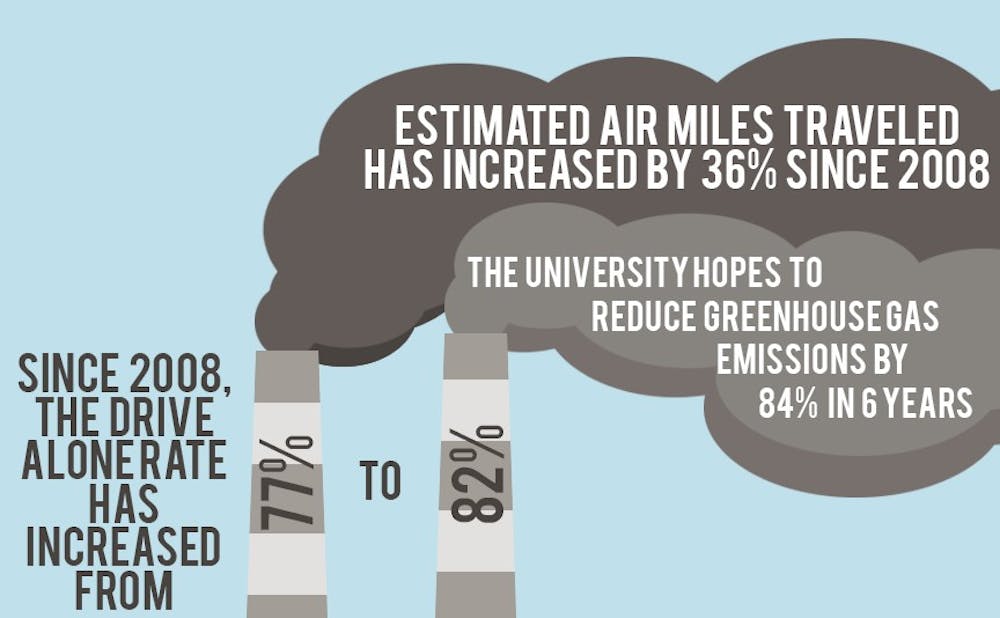An updated draft of Duke's Climate Action Plan was introduced at an event Thursday.
As part of Energy Week, Sustainable Duke and the University's facilities management department discussed the future of carbon neutrality at the event, called CarbonNetZero. Sustainability Director Tavey Capps addressed the University's progress towards becoming carbon neutral and the steps Duke will take in the coming years to achieve their sustainability goals.
The Climate Action Plan was initially drafted in 2009 with the ambitious goal to make Duke University Carbon Neutral by 2024. The 2018 update displayed progress with a 24 percent reduction in greenhouse gas emissions since the baseline and a 39 percent reduction in emissions per gross square feet, despite campus expansions of more than three million gross square feet.
Updates in the 2018 Climate Action Plan include focusing on internal emission reductions for energy and transportation. If all steps are taken as currently planned, the University hopes to be able to reduce greenhouse gas emission by 84 percent in the next six years.
Capps began by outlining the mission of Sustainable Duke: to educate, communicate and implement environmentally friendly initiatives on campus. Although many components contribute to Duke’s carbon footprint, she explained that transportation is by far the hardest to reduce and one of the sectors that has the biggest impact on the University’s carbon emissions.
The updated plan reveals that 16 percent of Duke's total emissions are due to employee scommuting, and that over 80 percent of employees drive to work alone. Employees also now live on average 3 miles farther away from campus as compared to 2007.
In order to reduce emissions, especially those connected to transportation, Capps presented several plans for the near future. Along with her team at Sustainable Duke, Capps said she plans to enhance and advocate for better public transit access, bolster existing carpooling and van-pooling programs, make Duke a more bike-able and walkable campus, support high-efficient, electric vehicle purchasing and create additional flexible parking options. She also wants to develop a network of existing alternative commuters to serve as ambassadors.
Another objective presented in the plan was to reduce emissions from air travel sponsored by the University.
The first was to encourage teleconferencing when possible. In some cases, like research being done in remote locations, this is not possible. Capps also noted plans to market existing programs that offset emissions associated with travel.
Some airlines not only produce fewer carbon emissions, but make it part of their missions to offset their emissions through things like plant trees. By working with these airlines, Duke can also work to reduce its carbon footprint. They also plan to develop a list of airline carriers ranked by sustainability metrics.
Another way to address issues with transportation is to look inwards at Duke’s fleet of cars, vans and buses. For example, two new electric buses will hit campus in 2020. Capps and her team also plan to implement a Green Fleet purchasing program, developing a list of hybrid or electric options for purchase through approved vendors.
Capps revealed that if these transportation projects are carried out, there will be an estimated 2 percent annual reduction in carbon emissions, including campus growth going out to 2024.
Some improvements in Duke’s carbon footprint thus far have stemmed from investments in more sustainable energy, as well as transitioning away from coal.
Casey Collins, Duke University Energy manager, discussed how energy is transferred at Duke. Half of the energy used on campus comes from heat, he said, and the shift away from coal to natural gas has had a significant impact.
Collins went on to explain that the rate at which energy has been increasing has been far lower than the rate at which the campus has been growing, indicating that new buildings are using less energy.
Corrections: This article was updated Friday morning to correctly identify Collins and to reflect that the University has transitioned from coal to natural gas, rather than steam. The Chronicle regrets the errors.
Get The Chronicle straight to your inbox
Signup for our weekly newsletter. Cancel at any time.

